
As outlined in the 2025 Activity Plan, the APNIC Blog will feature an ongoing series of posts highlighting economies across the Asia Pacific region. These articles, available via the “Economy Report” tag, will explore each economy’s Internet infrastructure, along with their challenges and achievements in capacity development, security, resilience, and community building. Bangladesh is first in the series.
Bangladesh, with a population exceeding 170 million, is the eighth largest population in the world. In recent years, Bangladesh has experienced significant economic growth, driven by its booming garment industry and infrastructure developments, making it one of the fastest-growing economies in South Asia.
Alongside these economic advancements, Bangladesh has made notable improvements in its connectivity and Internet infrastructure.
As of 2024, the ITU reports that approximately 44.5% of Bangladesh’s population are Internet users, a significant increase from 25.6% at the end of 2018.
Mobile broadband dominates connectivity due to the extensive 4G coverage, affordability of smartphones, and competitive data plans. Despite improvements, rural broadband expansion remains a significant challenge due to last-mile connectivity constraints. Fibre deployment is growing in urban areas, but expanding fixed broadband beyond city centres remains challenging.
The current interim government is already exploring satellite service options to expand coverage and resiliency and is looking to launch Starlink’s services within the near future. However, concerns have been raised about the impacts this development will have on operators in the already highly competitive market.
Bangladesh Internet infrastructure
IXPs
Bangladesh currently has eight operational Internet Exchange Points (IXPs), all licensed by the Bangladesh Telecommunication Regulatory Commission (BTRC) as National Internet Exchanges (NIXs). The first and largest of these is the Bangladesh Internet Exchange (BDIX), established in 2004 by the Sustainable Development Networking Foundation (SDNF). BDIX has a limited presence, with only two Points of Presence (PoPs) in Dhaka, the capital. In recent years, the Bangladesh Internet Service Provider Internet Exchange (ISPABNIX), operated by ISPAB, has emerged as a strong competitor. ISPABNIX is actively expanding its PoPs nationwide, aiming to connect major divisional cities beyond Dhaka.
NIXs play a crucial role in enhancing network performance in Bangladesh by enabling direct interconnections between local networks, reducing transit costs, and improving overall service quality. However, challenges persist, including inconsistent adoption by ISPs with only 7.57% of registered networks peering at NIXs.
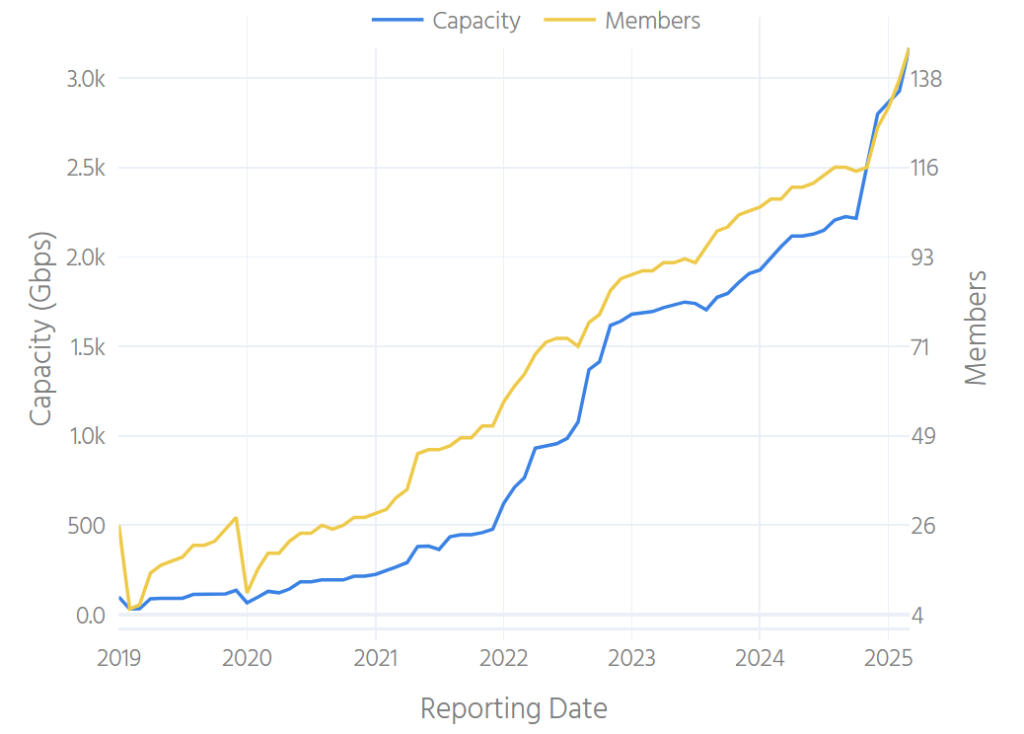
BDIX, with support from APNIC, WIDE Project, and Japan Registry Services, has deployed an M-Root instance in Bangladesh, enhancing local DNS resolution efficiency and reducing latency for Internet users.
Data centres
The rise of data centres in Bangladesh has been critical to supporting the increasing demand for online services. The economy’s data centre industry has grown rapidly, with several facilities now operational across Dhaka and other major cities. Currently, 47% of the top 1,000 websites in Bangladesh can be accessed through an in-economy server or cache.
There is still significant room for growth in terms of scale, reliability, and capacity. With no Content Delivery Networks (CDNs) currently operating in Bangladesh, platforms like Google and Facebook store their caches within mobile operator networks. This presents a key opportunity for IXPs in Bangladesh to expand and strengthen their role in the economy’s Internet ecosystem.
Submarine cables
Commissioned in 2005, SEA-ME-WE-4 was Bangladesh’s first submarine cable connection landing in Cox’s Bazar on the south-eastern Bangladesh coast. This significantly enhanced Internet connectivity by linking the economy to key global Internet hubs.
SEA-ME-WE-5 went operational in 2016 from Kuakata and improved bandwidth capacity and reduced latency issues, providing Bangladesh with an alternative route for international Internet traffic.
Looking ahead to 2026, SEA-ME-WE-6 is forecast to go operational via Cox’s Bazar providing further connectivity and resiliency to Bangladesh’s Internet landscape.
Submarine cable operations in Bangladesh were initially managed solely by Bangladesh Submarine Cable PLC (BSCPLC), a state-owned entity and a member of the SEA-ME-WE 4, 5, and 6 systems. However, in 2022, the BTRC revised its licensing guidelines to diversify bandwidth sources and enhance competition in response to rising Internet demand. Currently, four licensed submarine cable operators — Summit Communications, CdNet Communications, Metacore Subcom Ltd, and BSCCL — are responsible for expanding and maintaining submarine cable connectivity to enhance international bandwidth capacity and network redundancy.
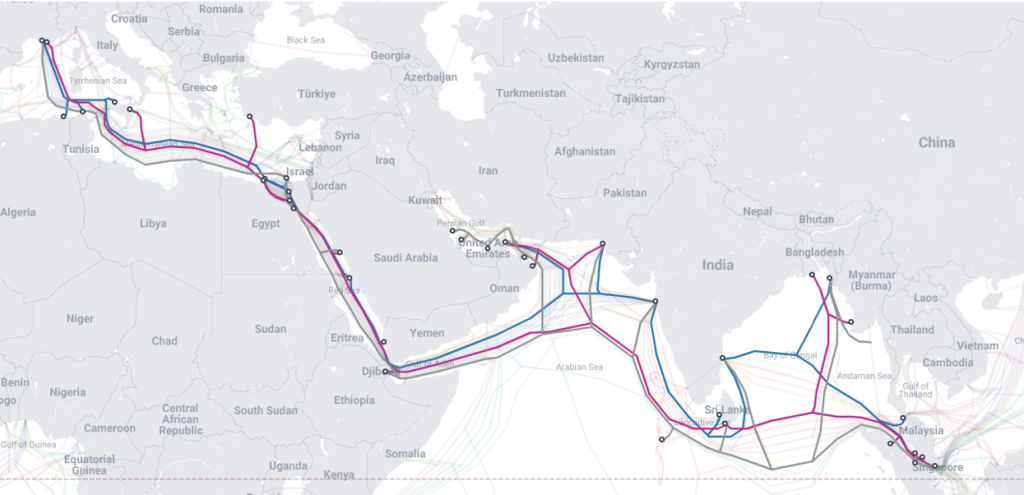
RPKI and IPv6 deployment
RPKI adoption in Bangladesh tells an interesting story. While the high percentages of Route Origin Authorization (ROA) protected prefixes (98% for IPv4 and 96% for IPv6) indicate a strong commitment to securing routing infrastructure, the implementation of Route Origin Validation (ROV) is low, with less than 1% of networks filtering out invalid prefixes and networks.
Large transit providers and ISPs may perceive ROV to be an added maintenance burden or have concerns about losing customers if a major issue arises due to dropping invalid routes. However, ROV is crucial for preventing routing errors and attacks that can cause significant network disruptions, making it essential for the security and stability of Bangladesh’s Internet infrastructure.
To achieve broader ROV adoption, Bangladesh must focus on education, regulatory support, incentivizing local peering, and simplifying implementation. By making ROV a priority in Bangladesh’s growing digital ecosystem, Bangladesh will be better positioned to secure its Internet operations and foster long-term growth in the digital economy.
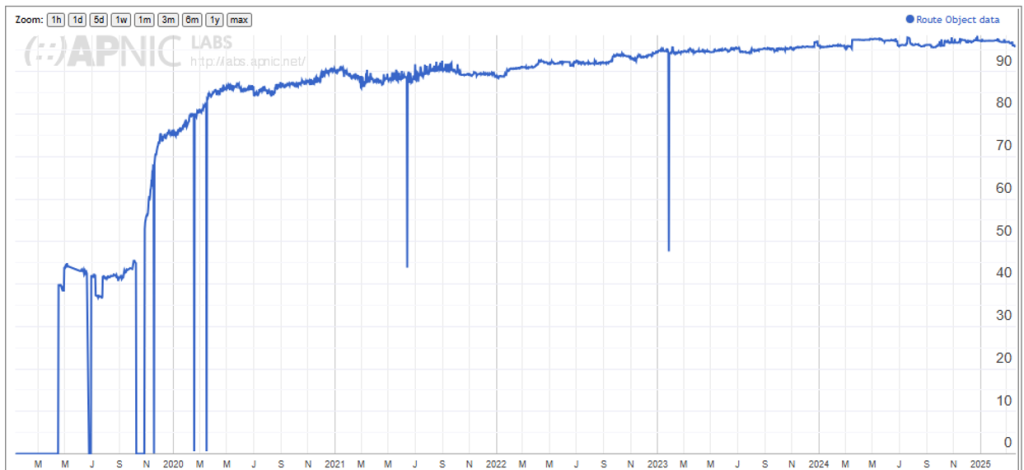
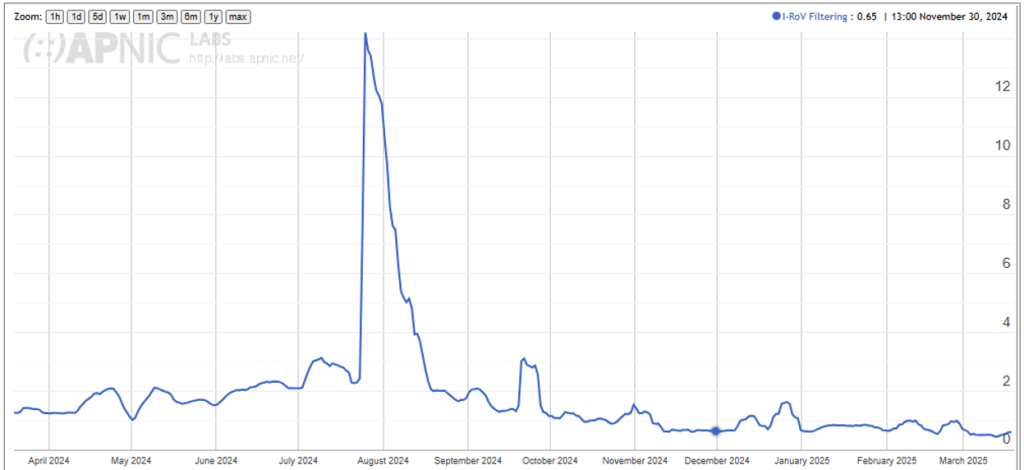
Bangladesh has made steady progress in IPv6 deployment in recent years, though there is still room for improvement. As of March 2025, approximately 18.3% of Internet users have an IPv6-capable connection. While major ISPs and mobile operators are gradually making the transition, legacy network equipment and lack of awareness among smaller ISPs are barriers to full adoption.
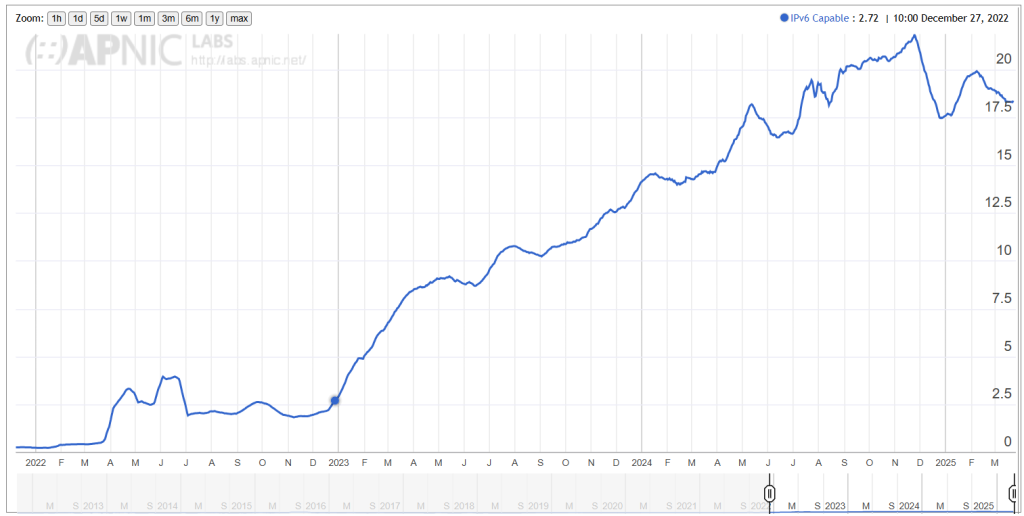
APNIC is committed to supporting Bangladesh to further increase its IPv6 deployment and will be delivering an IPv6 certification workshop in May to support capacity building.
APNIC is also working closely with BTRC to bring together key stakeholders to discuss how we can move the needle on IPv6.
Internet community
Bangladesh has an active and growing Internet community that plays a vital role in shaping the economy’s digital landscape. Various organizations and forums facilitate knowledge-sharing, collaboration, and policy development to strengthen the Internet ecosystem.
The Internet operations community in Bangladesh is highly engaged, regularly ranking among the top participants in APNIC conferences and activities. Maintaining this momentum will be crucial for its continued growth and long-term success.
The Bangladesh Network Operator’s Group (bdNOG), established in 2013, holds biannual conferences offering workshops, hands-on training, and a collaborative platform for professionals to advance network operations and Internet infrastructure. Over the years, bdNOG has grown significantly, becoming a key hub for knowledge exchange, collaboration, and skill development within the Internet community. APNIC has been a strong supporter of bdNOG and looks forward to engaging with the community at the upcoming bdNOG 19 in May 2025
Bangladesh Internet Governance Forum (BIGF), formed in 2006, is a multistakeholder platform that facilitates discussions on Internet governance policies, digital rights, cybersecurity, and infrastructure development in Bangladesh. BIGF hosts annual events that bring together government officials, industry leaders, and civil society representatives to address key Internet policy issues.
Bangladesh’s growing security community actively tackles security challenges, responds to incidents, and promotes best practices. BGD e-GOV CIRT, established in 2016, collaborates with international organizations to enhance cybersecurity and has played a key role in responding to national incidents, organizing cyber drills, and conducting training. As a member of APCERT and other regional initiatives, it strengthens defensive capabilities through knowledge exchange. Private-sector forums like Cybersecurity Summit Bangladesh and Phoenix Summit also bring together policymakers and experts to explore strategies for a resilient digital future.
Collaboration among network operators and the wider Internet community in Bangladesh and South Asia is growing, though market competition has occasionally limited knowledge sharing and local peering. Historically, ISPs favoured international transit providers, which increased costs and latency. However, industry forums like bdNOG, South Asian Network Operators Group (SANOG), and BTRC’s regulatory efforts all work towards encouraging greater cooperation.
The road ahead
The Internet landscape in Bangladesh is rapidly evolving, with significant improvements in mobile access and a growing focus on IPv6 and RPKI deployment. However, challenges remain, particularly in rural access and the need for a more robust Internet infrastructure. As the government and private sector continue to invest in these areas, the digital future of Bangladesh looks promising.
The views expressed by the authors of this blog are their own and do not necessarily reflect the views of APNIC. Please note a Code of Conduct applies to this blog.
